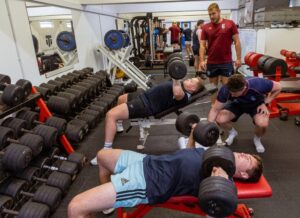Rugby is a physically demanding sport that requires a combination of speed, power, strength, and endurance. Rugby players need to be able to sustain high levels of physical exertion for 80 minutes of gameplay, which is why fitness is crucial for rugby performance.
But just how much fitness do rugby players need? The answer to that question is not straightforward, as it varies depending on the position played and the playing style of the team. However, there are some general guidelines that can help rugby players determine the fitness level they need to achieve.
Firstly, it’s important to understand the different energy systems used during a rugby game. Rugby is an intermittent sport, meaning players need to be able to perform repeated high-intensity efforts, interspersed with periods of lower intensity activity. The main energy systems used during rugby games are the aerobic and anaerobic systems.
The aerobic system is used for low-intensity activities such as jogging or walking, while the anaerobic system is used for high-intensity activities such as sprints, tackles, and scrums. Rugby players need to develop both energy systems to perform well on the field.
Forwards typically require more strength and power, while backs rely more on speed and agility. However, both forwards and backs need a good aerobic base to sustain their efforts throughout the game. A rugby player’s fitness level should be tailored to their position and playing style.
One way to assess rugby players’ fitness level is through the Yo-Yo Intermittent Recovery Test. This test measures the player’s ability to perform repeated high-intensity efforts with short recovery periods. The results of this test can provide valuable information on the player’s aerobic fitness level and help develop a tailored training plan.
In addition to aerobic fitness, rugby players need to develop their strength and power. Strength training can improve a player’s ability to make tackles, scrummage, and maintain their position during a ruck or maul. Power training, on the other hand, can help players develop explosive speed and agility, making them more effective at breaking through defensive lines and avoiding tackles.
To develop their fitness, rugby players should engage in a combination of cardiovascular, strength, and power training. Cardiovascular training can include running, cycling, or rowing, while strength training can include exercises such as squats, deadlifts, and bench press. Power training can include exercises such as plyometrics and Olympic lifting.
As for the frequency and duration of training sessions, rugby players should aim for at least three to four sessions per week, with each session lasting between 45 minutes to an hour. Training should be progressive, meaning players should gradually increase the intensity and volume of their training over time.
In conclusion, the amount of fitness required for rugby players depends on their position and playing style. However, it’s important for all players to develop both their aerobic and anaerobic energy systems, as well as their strength and power. A tailored training plan that combines cardiovascular, strength, and power training can help rugby players achieve their optimal level of fitness and improve their on-field performance. If you want access to such a plan created by coaches who’ve worked with the pros, checkout our Rugby Renegade Membership Program…




